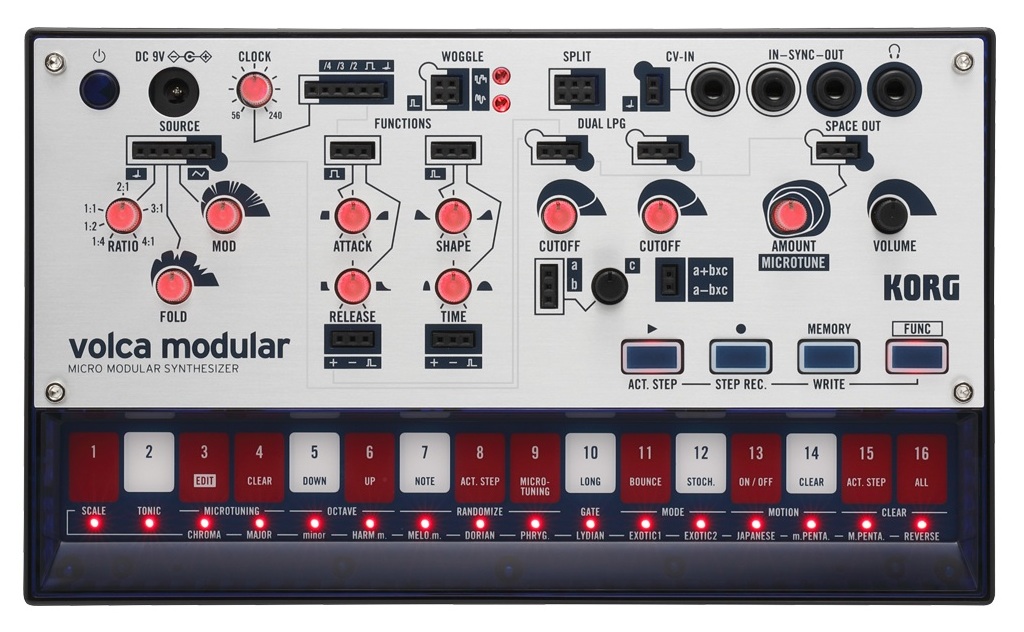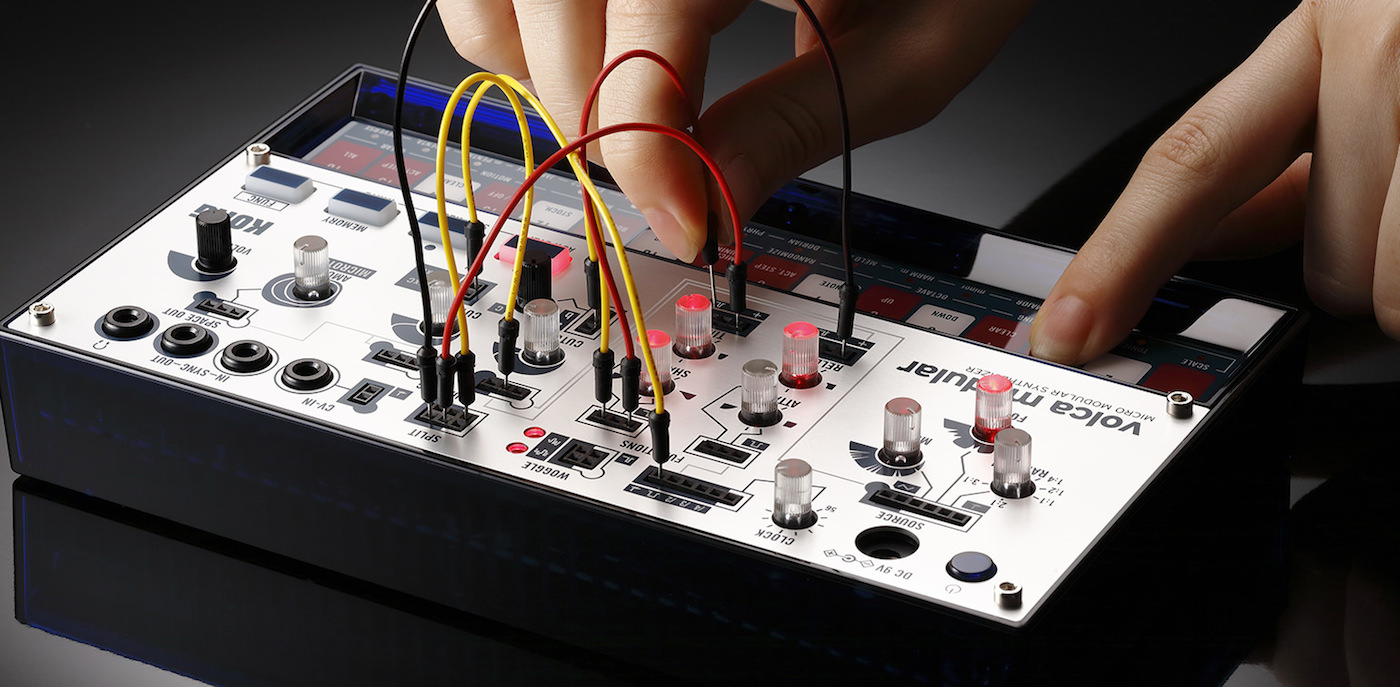New Gear Review: volca Modular Micro Synthesizer by Korg

Korg furthers the cutting-edge volca Series with the volca Modular, a comprehensive micro synth with not-so-micro capabilities.
Korg’s volca Series has continued to surprise. The introduction of the original three (mostly) analog devices back in 2013, designed by now-departed Korg engineer Tatsuya Takahashi, was monumental. It heralded a sea change in the amount of attention manufacturers had been paying to micro-sized gear aimed at tabletop performers—with diminutive prices to match.
Since, a whole new market segment has opened up and blossomed, with more and more quirky, portable instruments being released every quarter. For music makers of any level, these devices can be incredibly fun and inspiring to use—yet they are also accessible enough to appeal to those just getting started with their own music exploration.
Incredibly, many of these less expensive instruments are where music manufacturers are taking the most risks, both in terms of design and sonic character.
Arturia’s Mini and Micro Series, now with the intriguing MicroFreak, Teenage Engineering’s Pocket Operator Series, instruments from MFB, Jomox, Koma, Malekko, and many others all show a newfound willingness to push the envelope one step further at every trade event. The number of potential customers is in a rapid state of growth given the speedy turnaround of new product releases, and presentation videos popping up on YouTube continue to extol the virtue of the next new thing.
Spring 2019 saw Japanese music giant Korg announce a new model in the volca lineup that demonstrated the departure of Takahashi was not the end of the brand’s innovation. The volca Modular is a Buchla-inspired micro semi-modular analog synthesizer with a built-in sequencer and quite a lot of tricks up its sleeve. Let’s see what it’s all about.
Features
The volca Modular is based on what is largely known as the “West Coast” design of synthesizer engineering, led by Berkely-educated Don Buchla and his eponymous company. West Coast architecture—as opposed to Bob Moog’s designs that were happening simultaneously on the East Coast—favored taking a more experimental approach to synth circuit design.
Buchla famously wanted to do away with the keyboard all together. The volca Modular follows in this tradition, as it’s meant to be patched and experimented with as much as it’s meant to be played in the traditional way. You would think that having to cram an entire modular synth’s worth of connections onto the size of a VHS tape would be an immeasurable task, but Korg have done a commendable job making the volca Modular workable.

Though patchwork with the volca may be a tedious affair, the sonic possibilities on offer are plentiful.
There are eight modules on the front panel with a total of 50 patch points. Thin white lines on the panel show the pre-patched signal connections, which means that the volca Modular works right out of the box without any expertise. Beginners can jump right in, even if they are still figuring out the terminology associated with modular synthesis.
Signals can be audio, control, gate, or trigger, but any connection can be plugged into any other input point, greatly expanding the possibilities of the volca’s sounds. Audio inputs and outputs are labeled with small semi-circle signifiers, making it easier to distinguish audio routing from CV paths. Clear patch points signify input connections, while dark navy patch points are output connections. This color-based labeling system also helps in learning the Modular’s language quickly.
Twenty mini cables are included, as well as a reference table that explains each module’s function. The cables are obviously very tiny given the workspace involved (they are actually the same cables used in Moog’s Werkstatt, a DIY-kit based synth that was given to attendees of one of Moog’s annual Moogfests).
Korg have made understanding the signal path of the volca Modular as easy as possible, as it travels from left to right across the instrument. The “Source” module outputs a single triangle wave, though it’s possible to access the carrier and modulator oscillators separately in order to have a dual oscillator synth.
There’s also a knob for wavefolding, which adds more upper harmonics and complexity to the signal in a way that is similar to the Shape knob in the Minilogue series. Frequency modulation is also possible, with variable ratios available. Combining wavefolding with the FM modulation possibilities already covers a lot of sonic ground using just the single oscillator, especially in the lower registers. There are lots of gnarly sounds to be found.
Moving from left to right, there are two function generators available for modulation. The first is simple attack/hold/release envelope, while the second is a ”Rise-Fall” generator, which can be patched back into itself to create an LFO. Modulation outputs have both positive and negative outputs.
Instead of a normal subtractive filter, the volca Modular utilizes two low-pass gates. These combine filtering and envelope functions into one, and despite a lack of resonance adjustment, do the task well. The end of the signal chain features a handy digital reverb called Space Out. It’s worth noting that the rest of the synth’s modules are all analog. The reverb can go completely wet, which is nice for turning the volca Modular into a surprisingly deep drone machine. John Carpenter-esque horror soundtracks are easily reachable. The reverb can also be modulated, allowing a dynamic reverb effect per step. Already the volca Modular starts to show its uniqueness.
There are a few other modules that Korg has included in the volca Modular that greatly increase its sonic scope. The “Woggle” module is a random signal generator that acts as a sample and hold circuit, with the possibility of using either stepped or smooth outputs of random noise. A ”Utility” module allows for signals to be mixed or inverted. Both audio and control signals work in the Utility module, allowing it to function like a mini-mixer. Finally, there’s a ”Split” module which can either distribute one input to two outputs, or combine two signals into one.
The volca Modular features a sixteen-step sequencer, just like all the other volcas, but it adds a few new twists. Sequences can be recorded in Step or Live mode, unlike most of the rest of the series. Like the volca FM, sequences can be chained together.
The Modular adds new “Bounce” and “Stochastic” modes. Bounce mode runs forward and then reverse, whereas Stochastic mode features a forward motion that utilizes random jumps forward and backward. Both can be utilized with Active Step mode, which skips over deselected steps, thereby shortening the overall length of the sequence in real time. Combining the step sequencer functionality with modular patching creates a lot of new paths to explore.
Also new to the volca series is the ability to change both the scale and root note of the touch keyboard. Even more impressive is that microtuning is offered as well—the first time this has been seen in the volca series and no doubt a result of the microtuning implementation on the slightly larger Monologue.
Finally, the volca Modular features the ubiquitous (and somewhat useless) volca built-in speaker, a headphone jack, and is battery-powerable. It’s important to note that there’s no MIDI in, so you’ll need to use CV to sequence it externally if you plan on doing so. Importantly, the clock and CV in/out can be patched with both the micro patch cables and a normal 1/8” Sync cable, opening up how the Modular interacts with other gear.
In Use
Once you’ve wrapped your head around the functionality of each module, patching and programming sounds becomes a fairly expedient process, though you’ll start wishing you had several units so that you could leave patches as “presets”! It helps that Korg has included a healthy amount of patch cables, in both short and longer lengths. Since the faceplate of the instrument is fairly crowded, using the appropriate length of cable is essential. Korg have made a number of pre-programmed patches available on their website with clear, concise explanations of how to patch each one.
As mentioned, despite the fact that the Modular is essentially a single (or dual) oscillator synth, there’s a lot of sonic ground available. Combining the wavefolding with the frequency modulation in particular results in a rich tone dripping with harmonics, and when put through the Space Out, sounds like the work of a much more expensive instrument. It also works wonders as a bass synth. The volca is able to nail those subtle, subby tones, with the low-pass gates functioning as traditional filters but the modular architecture greatly adding to the number of paths you could take.
Another area the volca Modular excels is in polyrhythmic motion, given the fact that the clock of the sequencer can be modulated and has outputs for every fourth step, every third step, every other step, as well as a normal gate output. Patching the Space Out mix into the every-fourth-step output sends the signal to the reverb on only those steps. The cutoff on the filter of the low-pass gate can be patched in to trigger at an every-third-step interval; combine with motion sequencing and you’re well on your way to a patch that would be impossible on a normal, hardwired subtractive synthesizer.
The volca Modular also works wonders as an idea-generating machine, given the fact that there’s a Randomize function that can be applied to the notes in your sequence, which steps are active in the sequence, or the microtuning. Using the Stochastic mode in the sequencer adds another layer of randomness. And of course, all of the clear knobs can be motion-sequenced, just like all the other volcas, making it a snap to add further movement when you wish.
To Be Critical
One complaint that many users have commented on is how small and delicate the patch cables are, which is a fair concern given their narrow width and how easily they can be bent. A fair amount of care is needed when patching and un-patching, and it’s impossible to say how the connections will hold up over time.
And while the interface of the volca Modular does get slightly cluttered when doing a lot of patching, such is the case in the Eurorack realm as well.
Summing it Up
With eight modules, 50 patch points, a sixteen-step sequencer, and a lovely built-in digital reverb, the volca Modular is a groundbreaking instrument. While other volcas have had a wow and fun factor, none have held this much pure sonic potential. The fact that it does not need patch cables to be played right out of the box greatly increases its usability for beginners, while still maintaining the flexibility of an instrument with semi-modular architecture.
The volca Modular could be used as a testing ground for those who are Eurorack-curious, or as an educational tool for young synthesists who want to start playing with CV. Priced accessibly at $199, this funky and fun synth makes you feel like you are uncovering something new every time you turn it on.
Overall, Korg’s volca Modular is an incredible success. Not only is it one of the most unique volcas so far, it’s one of the most unique synthesizers I’ve ever come across.
Leo Maymind is a producer, DJ, and writer living in Los Angeles, CA. He is obsessed with sound, and you can reach him at lmaymind@gmail.com.
Please note: When you buy products through links on this page, we may earn an affiliate commission.







[…] Korg’s volca Series has continued to surprise. The introduction of the original three (mostly) analog devices back in 2013, designed by now-departed Korg engineer Tatsuya Takahashi, was monumental. It heralded a sea change in the amount of attention manufacturers had been paying to micro-sized gear aimed at tabletop performers—with diminutive Read more… […]